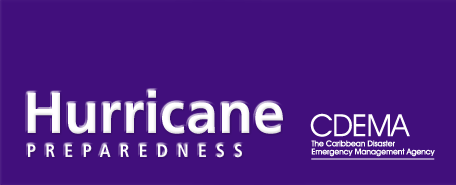|
|
Glossary
There are 83 entries in this glossary.| Term | Definition |
|---|---|
| Easterly Wave |
An inverted, migratory wave-like disturbance or trough in the tropical region that moves from east to west, generally creating only a shift in winds and rain. The low-level convergence and associated convective weather occur on the eastern side of the wave axis. Normally, it moves slower than the atmospheric current in which it is embedded and is considered a weak trough of low pressure. It is often associated with possible tropical cyclone development and is also known as a tropical wave. |
| El Niño |
A warming of the Pacific Ocean currents along the coasts of Peru and Ecuador near the Equator that is generally associated with dramatic changes or a shift in the weather patterns of the region. A major El Niño event generally occurs every 3 to 7 years and is associated with changes in the weather patterns worldwide including hurricane. |
| Emergency Operations Center |
A government emergency facility that serves as a central location for the coordination and control of all emergency preparedness and response disaster activities. Aliases (separate with |): EOC
|
| Emergency Public Shelter |
Generally a public school or other such structure designated by county or city officials as a place of refuge. A volunteer group such as the American Red Cross or Salvation Army usually manages a shelter. |
| Extratropical |
A term used in advisories and tropical summaries to indicate that a cyclone has lost its "tropical" characteristics. The term implies both poleward displacement of the cyclone and the conversion of the cyclone's primary energy source from the release of latent heat of condensation to baroclinic (the temperature contrast between warm and cold air masses) processes. It is important to note that cyclones can become extratropical and still retain winds of hurricane or tropical storm force. |
| Extratropical Cyclone |
A cyclone in the middle and high latitudes often being 2000 kilometers in diameter and usually containing a cold front that extends toward the equator for hundreds of kilometers. These cyclones form outside the tropics, the center of storm is colder than the surrounding air, have fronts and the strongest winds are in the upper atmosphere. |
| Eye |
The center of a tropical storm or hurricane characterized by a roughly circular area of light winds and rain-free skies and the lowest pressure. An eye will usually develop when the maximum sustained wind speeds exceed 78 mph. It can range in size from as small as 5 miles to up to 60 miles (20-50 km) but the average size is 20 miles. In general, when the eye begins to shrink in size, the storm is intensifying. |
| Eye Wall |
An organized band of convection surrounding the eye, or center, of a tropical cyclone. It contains cumulonimbus clouds, severest thunderstorms, heaviest recipitation and strongest winds. |


























